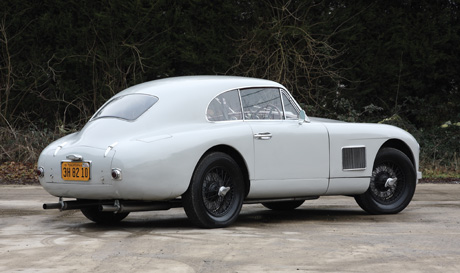SCM Analysis
Detailing
| Vehicle: | 1950 Aston Martin DB2 Vantage |
| Years Produced: | May 1950 - April 1953 |
| Original List Price: | $4,800 |
| SCM Valuation: | With provenance, $350k - $400k |
| Tune Up Cost: | $1,200 - $2,400 |
| Distributor Caps: | $75 |
| Chassis Number Location: | Brass plaque in engine compartment and on top of upper, right-side chassis rail |
| Engine Number Location: | Stamped on top right side of front timing cover |
| Website: | http://www.astonmartins.com |
| Alternatives: | Ferrari 166 or 212 coupe, Alfa Romeo 1900 CSS, Lancia Aurelia convertible |
This car, Lot 270 at RM’s Sporting Classics of Monaco sale on May 1, 2010, was sold for $395,158, which continues a solid trend in the rising value of historically correct and significantly rare Aston Martin automobiles.
The Aston Martin DB2 featured here is one of a number of recent early David Brown-era cars that have blown through their auction catalog estimate. This shows that it is very difficult indeed to properly calibrate what a buyer will pay to add a historically important car to their collection versus a run-of-the-mill street car. In my view, if the buyer had instead purchased a concours-condition street DB2 Coupe without any racing pedigree there would have had enough change left over to buy a nice 2010 Aston Martin V8 Coupe. That’s the difference.
The value of old-school history
Should there be that much value disparity between a street car and a car that has a cache of wonderful, period black-and-white photography from places such as Sebring, Le Mans or Watkins Glen – and driven by gents named Collier, Shelby, Moss, Salvador? I guess so. Brother, there’s nothing like appreciating and understanding the value of that grainy old school photography. There’s no denying that a car is sexier if it is the one in the period shots.
New and mature collectors alike have for some time been seeking out examples of favorite classics that will allow them an obvious leg up against their peers, especially when they’re trying to gain an entrée into events that focus on historically significant cars.
As a bonus here, lot number 270 seems to be a turnkey example, which adds greatly to the appeal.
We all hear of great barn finds that have been off the radar for quite some time, but the reality of taking that that romantic notion and putting it back on the road, in a condition reliable enough to compete in a 1,000-mile event, may consume stacks of cash and years of time before it can turn one wheel revolution in an adrenaline-burning rally. There’s a huge upside to having something that has been well maintained, proven and just needing a new owner to add gas and fill out event applications.
Racing past blows away imperfections
It is paramount that proper perspective on the provenance of a vehicle must not be under estimated these days.
If this car was devoid of the young Sebring race history and its other early 1950s provenance, an appraiser or savvy collector (perhaps trying to beat the seller’s price down) might have unfairly described it in a slightly more jaundiced way. It could have been reduced to “A nice older survivor that has been well maintained by a proper marque specialist but is an example that suffers from an unfinished complete color change and is missing its engine case number.”
Granted, early three-piece DB2s are as rare as rocking-horse manure. If you truly want one, this would have been great opportunity to make the acquisition, but the car does have some large, glaring exceptions. Needless to say, the significant provenance rightfully overshadows the cosmetic foibles and potential engine number issue.
United Kingdom marque specialist Nicholas Mee of London, England and Bonham’s auction house both recently sold early important DB2 coupes, so this car is not a fluke. The result of this auction, although higher than RM’s estimate, may not have been a surprise to anyone chasing a nice example.
I really feel that the new owner was mature in his decision to not let imperfections get in the way of this great purchase. Too many times in today’s market, potential buyers let the perception of imperfections get in the way of what is truly more important. I doubt the exclusion of a factory tool roll or original owner’s manual would have made the car any less exciting to drive. Who cares if the front timing cover has been replaced? The car would not be safer on the original rims and tires either. I hope you see what I’m driving at..
In a great many instances, cars that have been campaigned may not have a matching-numbers engine. They also may have cosmetically modified in period, and they may have undergone radical modifications to satisfy new racing regulations. The important lesson is to not get all caught up in useless anorak chatter – and just grab your checkbook with the confidence to go for it.
This car was well bought, hopefully by someone who will continually use it as it was designed to be used. The new owner should give this car a proper second life, wear it out – and then fix it and use it again.
